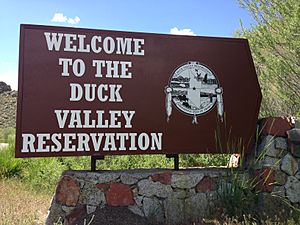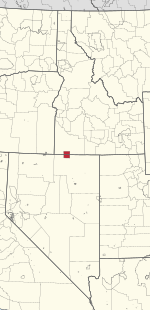Duck Valley Indian Reservation facts for kids
Quick facts for kids
Duck Valley Indian Reservation
Tokkapatih
|
|
|---|---|

Entrance sign to Duck Valley Reservation
|
|

Location of the Duck Valley Indian Reservation
|
|
| Tribe | Shoshone-Paiute |
| Country | United States |
| State | Idaho and Nevada |
| County | Owyhee County, Idaho and Elko County, Nevada |
| Area | |
| • Total | 1,166.5 km2 (450.4 sq mi) |
| Website | Duck Valley Shoshone-Paiute Tribes |
The Duck Valley Indian Reservation (Shoshoni: Tokkapatih) is a special area of land. It was set aside in the 1800s for the Shoshone and Paiute tribes. These tribes are officially recognized by the United States government.
This reservation is in a quiet, isolated spot in the high desert of the western United States. It sits right on the border between Idaho and Nevada. This border is known as the 42nd parallel.
The reservation is shaped like a square. It is split almost equally between the two states. About half of the land is in southern Owyhee County, Idaho. The other half is in northwestern Elko County, Nevada. The total land area is about 450 square miles. In 2000, about 1,265 people lived there. Most of them lived on the Nevada side.
In 2016, a new law was passed called the Nevada Native Nations Land Act. This law added more land to six tribes in Nevada. The Shoshone-Paiute Tribe received 82 acres of Forest Service land. This land was added to their reservation.
The main community on the reservation is Owyhee, Nevada. It is about 5,400 feet above sea level. Owyhee is almost the same distance from two bigger cities. It is 98 miles north of Elko, Nevada. It is also 97 miles south of Mountain Home, Idaho.
Contents
History of the Duck Valley Reservation
How the Reservation Started
On April 16, 1877, President Rutherford B. Hayes created the Duck Valley Western Shoshone Reservation. He did this with an official order. It was also meant for the Northern Paiute people.
Even though the Native Americans had this land, some local settlers and politicians tried to make them leave in 1884. They wanted the tribes to move to another reservation in Fort Hall, Idaho. But the chiefs of the tribes bravely fought to stay on their land. They succeeded in keeping their home.
Growing the Reservation
Later, a group of Northern Paiute joined another Shoshone group in the Bannock War of 1878. After the war, the survivors were sent to a camp. This camp was at the Yakama Indian Reservation in Yakima County, Washington. When they were set free, the Northern Paiute returned to Duck Valley.
To make sure there was enough room for them, President Grover Cleveland made the reservation bigger. He did this with another official order on May 4, 1886.
President William Howard Taft expanded the reservation again on July 1, 1910. This made the reservation its current size. It was quite unusual for a reservation to be made bigger so many times. Usually, federal actions made reservations smaller.
Tribes in the Region
The Shoshone-Paiute Tribe of Duck Valley is one of five tribes in Idaho that are recognized by the government. Each of these tribes has its own reservation. The other tribes in Idaho are the Coeur d'Alene, Kootenai, Nez Perce, and Shoshone-Bannock. There are also several other recognized tribes in Nevada. These include other Shoshone and Paiute groups.
Sister Reservations
- Fort Hall Indian Reservation, Idaho
- Fort McDermitt Indian Reservation, Oregon/Nevada
- Duckwater Shoshone Tribe of the Duckwater Reservation
- Summit Lake Indian Reservation
- Pyramid Lake Indian Reservation
- Reno-Sparks Indian Colony
Notable Members
- Tina Manning: She was an activist who worked for water rights. She passed away in 1979.
Highways
 - Idaho State Highway 51 goes north from the reservation. It leads to Bruneau and then to Mountain Home. From there, you can connect to Interstate 84.
- Idaho State Highway 51 goes north from the reservation. It leads to Bruneau and then to Mountain Home. From there, you can connect to Interstate 84. - Nevada State Route 225 goes south from the reservation. It leads to Elko and then to Interstate 80.
- Nevada State Route 225 goes south from the reservation. It leads to Elko and then to Interstate 80.


